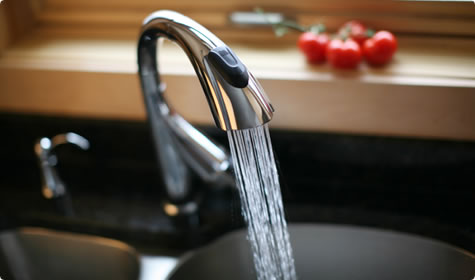 |
 |
 |
It's easy to take running water for granted. But in California, dwindling fresh water supplies and a growing population mean that potable water may be on its way to becoming an endangered natural resource. You can do your part to protect our communal water supplies with some simple changes in your home.
Low-flow faucets and showerheads can cut water usage by as much as 40% with little noticeable difference to the person who is washing up. High-efficiency toilets perform well and can significantly reduce your water use.
The beauty of these products is that they're not just good for the environment—they can save you money too. Using less water means lower water and sewer bills and lower energy bills for heating water.
If you're thinking about buying a new toilet or showerhead, check out the high-efficiency products listed in the Green Product Directory. Although we don't list individual kitchen and bathroom faucet products because there are so many to choose from, we do provide tips below on what you need to know when shopping for a new faucet or making your old faucet more efficient.
Faucets
Standard kitchen, bathroom and laundry room faucets manufactured after 1992 are designed to allow a flow of no more than 2.5 gallons of water per minute (gpm). Older faucets use even more water.
If you are in the market for a new faucet, you have plenty of products to choose from that are more efficient than the minimum required by law. Select kitchen and laundry room faucets that use no more than 1.8 gpm. Select bathroom faucets that use no more than 1.5 gpm.
If you have a water-wasting faucet that you don't want to replace, you can install a flow reducer. Flow reducers come in many forms and are readily available in the plumbing department of your local home improvement store. The easiest and least expensive option is an aerator that screws into the faucet's tip. An aerator adds air to the water stream to make the flow feel stronger.
Another type of flow control device is a laminar flow control, which creates multiple small-diameter parallel streams of water that are not aerated. Both types of devices give the feeling that water is flowing at a higher rate than it actually is. Another option is flow control valves. These are installed under the sink at the junction of the angle-stop and faucet, and can limit water flow down to 1.5 to 0.5 gpm per side (hot and cold).
More bath fixture tips
- Get money back. Check with your water provider for possible rebates. Many water providers and local governments give property owners incentives to install water-saving toilets, faucets and showerheads because these fixtures reduce demand for water supplies and reduce the volume of wastewater that needs treatment.
- Measure how much is going down the drain. Want to know how much water a showerhead or faucet really uses? To measure the flow rate, you'll need a watch and a bucket or container that holds at least one gallon and is marked with volume measurements. Turn the taps until they are fully open, hold the container under the stream of water, and time how long it takes to obtain one gallon of water. Then divide 1 gallon by the time (in minutes). For example, if it takes 30 seconds to obtain 1 gallon, then the flow rate is 2 gpm (1 gallon / 0.5 minutes). If it takes 18 seconds to obtain 1 gallon, then the flow rate is 3.3 gpm (1 gallon / 0.3 minutes).
- Maintain it. If you add a flow reducer to a faucet tip, remember to do simple periodic maintenance to keep it from becoming clogged. Just unscrew the flow reducer, rinse it clean of debris, and screw it back on.
- Find out more. For more information about high-efficiency faucets, showerheads and toilets and other tips on saving water, go to www.epa.gov/watersense.